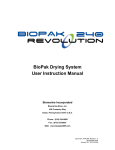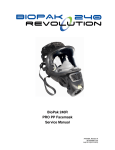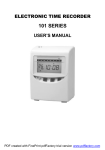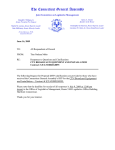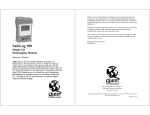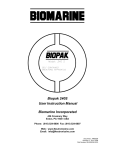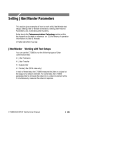Download BioPak 240R User Instructions 1437 - BioPak 240 Revolution 4
Transcript
BioPak 240R Closed-Circuit, Self-Contained Breathing Apparatus User Instructions 1437 A47D256, Revision G B5-06-6000-22-0 [ECO 9661] March 2013 BioPak 240R User Instruction Manual A47D256, Revision G Contents WARNINGS 3 1. INTRODUCTION 4 1.1 1.2 1.3 Breathable Oxygen Apparatus Duration Personnel Training 4 4 4 1.4 1.5 Servicing Spare Parts 4 5 2. APPARATUS DESCRIPTION 6 2.1 2.2 2.3 General Harness Housing 6 6 6 2.4 2.5 2.6 Breathing Loop Oxygen Delivery System Oxygen Cylinder 7 7 7 2.7 2.8 2.9 Alarming System Facemask Optional Attachments 7 8 8 3. PREPARATION FOR USE 10 3.1 3.2 3.3 Maintenance Tag Inspection Mask Preparation Moisture Sponge Preparation 10 10 10 3.4 3.5 3.6 PCM Installation Carbon Dioxide Scrubber Installation Coolant Canister Installation 10 11 12 4. DONNING THE APPARATUS 4.1 4.2 4.3 13 Donning the Apparatus Donning the Facemask Activate Oxygen Supply 13 13 14 5. PRACTICAL USE 15 5.1 5.2 5.3 Breathing the Apparatus Speaking Alarming System 15 15 15 5.4 5.5 5.6 Coolant Replacement Emergency Bypass Emergency Operation 15 15 15 6. DOFFING THE APPARATUS 6.1 16 Doffing Instructions 16 7. APPARATUS SPECIFICATIONS 17 Page 2 of 19 BioPak 240R User Instruction Manual A47D256, Revision G WARNINGS Please Read Carefully and Fully Understand This manual is for use by personnel trained in the use and care of compressed oxygen, closed-circuit breathing apparatus, and MUST NOT be used as a self-teaching guide by untrained users. Failure to understand or adhere to the BioPak user instructions and BioPak benchman manual may result in injury or death. Biomarine Inc. has taken great care to ensure that the information in the manual is accurate, complete and clear. However, Training & Technical Support Services will be pleased to clarify any points in the manual and answer questions on Biomarine breathing apparatus. The following warnings are in accordance with certifying authority requirements and apply to the use of breathing apparatus in general: Breathing apparatus user must be fully trained in the use and care of closedcircuit, self-contained, compressed oxygen breathing apparatus. Ensure that the selection of the apparatus type is sufficient for the tasks being undertaken and the hazards likely to be encountered. Please refer to National Regulations for guidance. Adequate protection may not be provided in certain highly toxic atmospheres. The apparatus must be tested and serviced in accordance with the BioPak 240R Benchman Manual. The quality of oxygen used to supply and charge the breathing apparatus must be medical or aviation grade oxygen with a moisture content less than 50 mg/m3 at 207 bar. Ensure that a good seal can be obtained between the face and facemask. The wearing of beards, side-burns or spectacles may adversely affect the sealing of a facemask to the wearer’s face. The apparatus is not designed for use underwater diving. The harness must not be used as a vehicle seat or fall arrest restraint. Replacement of the alarm system battery shall be performed in area atmospheres known to be safe and non-explosive. The improper use of closed-circuit breathing apparatus carries a risk of carbon dioxide poisoning of user. Users shall be fully trained in recognizing the effects of carbon dioxide poisoning. Carbon Dioxide Scrubbers must be stored at a temperature between 4oC and 32oC to prevent degradation of the absorbent material. Carbon Dioxide Scrubbers must be utilized with the supplied Moisture Pad to prevent scrubber canister flooding that may lead to elevated carbon dioxide levels in the breathing gas. DISCLAIMER Failure to comply with these instructions or misuse of the apparatus may result in: death, injury or material damage, and invalidate any warranty or insurance claims. This manual presents the minimum requirements for BioPak utilization. Page 3 of 19 BioPak 240R User Instruction Manual A47D256, Revision G 1. INTRODUCTION 1.3 Personnel Training 1.1 Breathable Oxygen Personnel who use closed-circuit, selfcontained, positive-pressure, compressed oxygen breathing apparatus must be fully trained in accordance with these instructions and national regulations. Oxygen used to supply or charge the breathing apparatus must be medical or aviation grade oxygen with moisture content less than 50 mg/m3 at 207 bar. The composition of suitable oxygen is given below and provides the maximum level of contaminates in the source oxygen acceptable for use in the BioPak. These instructions cannot replace an accredited training course provided by qualified instructors in the proper and safe use of Biomarine breathing apparatus. Oxygen: 99.5% minimum mole Carbon Dioxide: 300 ppm maximum Carbon Monoxide: 10 ppm maximum Please contact Training & Technical Support Services or your local distributor for training course details. The purity/quality of oxygen used to supply and charge breathing apparatus should be tested periodically in accordance with national regulations. 1.4 Servicing National regulations must be observed. Personnel dealing with compressed oxygen and compressed oxygen cylinders must be fully trained in the use and handling of compressed oxygen. 1.2 Apparatus Duration The apparatus will provide the user with 440 liters of compressed oxygen and has been rated for a 4-hour duration based upon machine testing at a breathing rate of 30 liters/minute according to specifications of EN145. Actual duration of the apparatus will vary to factors such as: Workload: high work rates will increase consumption rates of oxygen. Facemask Seal: poor seal of mask will result in system leaks and high oxygen consumption rates. Physical Fitness of Wearer System Leaks: leaks in the BioPak system will result in high oxygen consumption. The BioPak 240R must be serviced at scheduled intervals by qualified benchmen personnel who have completed a formal training course and hold a current certificate for the service and repair of Biomarine breathing apparatus. Turn Around Maintenance shall be performed after each use of the BioPak 240R as detailed in the BioPak 240R Benchman Manual. Long Term Maintenance must be performed on a monthly basis, if the BioPak is in constant use; or, on a quarterly basis if the BioPak is being used less than once per month, as defined in the BioPak 240R Benchman Manual. Electronics Intrinsic Safety Assessment Procedure must be performed each time the batteries are replaced in the alarming system as defined in the BioPak 240R Benchman Manual. Benchman training and service contracts can be provided by contacting Training & Technical Support Services. It is important that all wearers are aware of the above factors and take account of them when assessing BioPak duration. It is equally important that all wearers understand that the BioPak 240R respirator is a positive-pressure apparatus. Leaks in the apparatus itself or in the seal between the wearer’s face and the facemask will lead to the apparatus adding additional oxygen to maintain positive pressure. Page 4 of 19 BioPak 240R User Instruction Manual A47D256, Revision G 1.5 Spare Parts Spare parts, accessories, general information and factory service can be obtained by contacting Training & Technical Support Services. Reference details provided in the BioPak 240R Benchman Manual concerning spare part identification, accessory identification and BioPak factory service. Training & Technical Support Services: Biomarine Inc. A Wholly Owned Subsidiary of Neutronics Inc. 456 Creamery Way Exton, PA 19341 United States of America Tel: +1 610.524.8800 Fax: +1 610.524.8807 Web: BioPak240r.com Customers can also contact their local authorized Biomarine Distributor for training, product support, service or maintenance. Reference documentation supplied with sales order for standard terms of warranty. Page 5 of 19 BioPak 240R User Instruction Manual A47D256, Revision G Equipment with protection level (EPL) GA 2. APPARATUS DESCRIPTION 2.1 General BioPak 240R is a closed-circuit, positivepressure, self-contained breathing apparatus (CCBA) for use in long-duration missions into atmospheres that are immediately dangerous to life and health (IDLH). Applications will include mine rescue, fire-fighting, confined space entry, domestic preparedness, military, tunnel rescue and HAZMAT. All versions of the BioPak 240R feature a backpack-style housing that is worn over the shoulders and hips of the wearer. A pressure gauge is supplied to indicate remaining stores of oxygen and two visual alarms and one audible alarm is provided for system status. The closed-circuit design will recycle the wear’s exhalation breath by removing carbon dioxide, replacing consumed oxygen, trapping condensation and cooling the breathing gas. IEC 60079-0:2007/10/01 Ed:5 Explosive Atmospheres-Part 0:equipment-General Requirements IEC 60079-11:2006/07/01 Ed:5 Explosive Atmospheres-Part 11: Equipment protection by intrinsic safety “I”; CORR 2006/12/08 EN 60079-26:2006/08/01 Ed:2 Explosive Atmospheres-Part 26; Equipment with protection level (EPL) GA BioPak 240R is “CE” marked in accordance with EEC Directive 89/686/EEC. BioPak 240R Monitor is marked Ex ia I/IIC T4 Ma/Ga -20oc <+ Tamb <+ +60oc NOTIFIED BODIES: The positive-pressure design will maintain internal breathing gas pressures slightly above external atmospheric pressure. This feature will provide increased protection against the inward migration of external toxins to the wearer. All external housing components are static dissipative and flame retardant. BioPak 240R is approved to the following European Standards: EN 136:1998 Respiratory protective devices - Full face masks EN 145:2000 Respiratory protective devices – Selfcontained, closed-circuit breathing apparatus compressed oxygen type Directive 97/23/EC Pressure Equipment Directive EN 60079-0:2009/08/01 Electrical apparatus for explosive gas part 0: General Requirements EN 60079-11:2007/01/01 Explosive Atmospheres-Part11: Equipment protection by intrinsic safety “I” EN 60079-26:2007/03/01 Explosive Atmospheres-Part 26: Central Institute for Labour Protection (Notified Body No. 1437) Wierzbowa 48 90-133 Lodz, Poland Intertek Testing & Certification Ltd Intertek House, Cleeve Road Leatherhead, Surrey KT22 7SB United Kingdom TUV America, Inc. Industry Service 5 Cherry Hill Drive Danvers, MA 01923 United States of America Please contact Biomarine Inc for further apparatus approval details. 2.2 Harness The BioPak harness is provided as a padded harness to increase wearer comfort. The flame-retardant harness is manufactured from Kevlar™ and Nomex™ materials with stainless steel hardware. The harness is attached directly to the apparatus via locking stainless steel screws. 2.3 Housing The backpack-style housing is injection molded from a flame-retardant polycarbonate/stainless steel alloy that provides light weight, high strength and static dissipation. The housing consists of a lower portion and an upper portion that Page 6 of 19 BioPak 240R User Instruction Manual A47D256, Revision G snaps together in a secure fashion without the need for connection hardware. 2.4 Breathing Loop add will provide 80-100 liters/minute of oxygen flow and is utilized only for emergency situations. 2.6 Oxygen Cylinder The oxygen cylinder is a fully wrapped aluminum carbon fibre composite cylinder that is secured into the apparatus via connection to the pressure regulator and a hold down strap. The cylinder will provide containment of the oxygen supply at a 207 bar to provide 440 liters of breathable oxygen to the wearer. The breathing loop consists of the breathing chamber, breathing hoses, facemask connector and facemask. 2.7 Alarming System The breathing chamber consists of the center section, center section lid and diaphragm. The spring loaded diaphragm will maintain positive pressure within the apparatus. All oxygen gas additions will occur within the breathing chamber as well as over pressure venting. Carbon dioxide is removed from exhalation gas by the carbon dioxide scrubbers located within the breathing chamber. Excessive moisture will be retained by the moisture containment sponges located within the center section. Inhalation breathing gas cooling will be achieved as the gas travels around the two coolant canisters of the breathing chamber. 2.5 Oxygen Delivery System Oxygen will be delivered from the oxygen cylinder to the breathing loop through a pressure regulator and manifold system in one of three different methods. Pressure demand oxygen additions are provided whenever the diaphragm of the breathing chamber reaches the upper level of its travel and depresses the demand valve plunger. Additions will be made at 80 liters/minutes whenever the demand valve plunger is depressed. Pressure demand additions occur whenever the wearer consumes more oxygen than is supplied by the constant add. Constant add oxygen additions are continually added to the breathing loop at an average rate of 1.8 liters/minute. This oxygen addition rate is equivalent to the oxygen consumption rate of a wearer at a moderate work rate. Emergency add oxygen additions occur whenever the wearer depresses and holds the red emergency bypass button. This The alarming system consists of a pneumatic pressure gauge and an electronic monitor to provide the wearer with independent and redundant system status indications. The pressure gauge is mounted on the harness and retained by a snap strap and magnet. Remaining stores of oxygen will be indicated on the gauge and a red band of color will indicate to the wearer when oxygen stores have reached 25% of capacity. The pressure gauge is protected against sudden loss of oxygen stores in the event of gauge line severing by a manual disconnect located at the gauge pass through point of the housing. The electronic monitor will provide the wearer of indications of system status as listed below through the LED located on the pneumatic pressure gauge and via an alarm horn located on the monitor package. Condition Alarm Action System Ok Flashing Green System Fault Flashing Red Horn Sounding End of Service Life Flashing Red Horn Sounding Ice Reminder Flashing Blue Low Battery Flash Red, Green, Blue Horn Sounding Page 7 of 19 BioPak 240R User Instruction Manual A47D256, Revision G 2.8 Facemasks BioPak 240R is approved for use with the PRO and AV3000 full facemasks, all of which conform to EN136, Class 3. All facemasks are provided with five-point, fully adjustable head harnesses. To prevent fogging during use, the internal surface of the facemask lens is covered with a permanent anti-fog film that will not require the application of any anti-fog spray or wipe. PRO Mask All facemasks connect to the apparatus via a push button, bayonet hose connection. Speech diaphragms are provided to allow verbal communication and all masks are provided with a magnetic wiper the is for optional user utilization. The polycarbonate visors of all facemasks conform to EN 166, Grade B for impact resistance. 2.9 Optional Attachments Hydration systems provide the wearer with a source of drinking liquid without breaking the seal of the breathing loop to the external atmosphere. Anti-crush rings provide breathing hose crushing and restriction protection. Kevlar™ breathing hose covers provide additional abrasion protection to breathing hoses. Radiant heat guards provide additional breathing hose protection against high radiant heat and direct flame contact. Page 8 of 19 AV3000 Mask BioPak 240R User Instruction Manual A47D256, Revision G Phase Change Module (PCM) provides cooling to the breathing gas when ice coolant is not utilized. Note that the PCM is required when the ice coolant is not utilized. Contact Biomarine or your local distributor for additional details and supply of optional attachments. Page 9 of 19 BioPak 240R User Instruction Manual A47D256, Revision G 3.3 Moisture Sponge Preparation 3. PREPARATION FOR USE Prior to donning the apparatus the wearer shall conduct the following procedures to ready the apparatus for use. 3.1 Maintenance Tag Inspection Remove the moisture sponges from the breathing chamber and wet until supple. Wring out excess water and replace into the breathing chamber. If the sponges are not pre-wetted prior to use the breathing air to the wearer will be warmer than usual. Note: Pre-wetting of the sponges is OPTIONAL but will provide cooler initial breathing gas temperatures. 3.4 PCM Installation If the ice canisters are not utilized that install the PCM canister into the center section as depicted below. Locate and inspect the maintenance tag that should be attached to the apparatus. Verify that all items on the tag are properly dated and initialed. If the maintenance tag is missing or not properly completed the apparatus MUST NOT be placed into service until full turn around maintenance has been completed as specified in the BioPak 240R Benchman Manual. 3.2 Mask Preparation Do not apply anti-fog agents of any kind to the facemask. The facemask is supplied with a permanent anti-fog film that will prevent fogging. If the optional magnetic wiper is used, soak both chamois surfaces of the wiper pieces with anti-fog or water and install onto the lens of the facemask so that the chamois side of each piece in is direct contact with the lens. The wiper is to be installed with the thinnest section positioned on the inside surface of the mask. Page 10 of 19 BioPak 240R User Instruction Manual A47D256, Revision G 3.5 Carbon Dioxide Scrubber Installation Note: The scrubbers may have already been installed by the BioPak technician prior to use. In such cases the user should verify the scrubber expiration date has not been exceeded by inspecting the date recorded on the maintenance tag. Remove the moisture pad, depicted above in sealed bag, from the sealed pouch and install it into the breathing chamber as depicted. Do not allow the pad to become pinched between the breathing chamber wall and the scrubber. The pad shall be located right next to the baffle opening that leads to the coolant canisters. Inspect the expiration date of the carbon dioxide scrubber to ensure that it is not expired. Record the serial number and expiration date of the scrubber onto the maintenance tag or affix the scrubber label to the rear of the tag. Proper moisture pad installation. WARNING: Failure to install the moisture pad can lead to scrubber flooding that will result in elevated carbon dioxide levels in the breathing gas that may lead to injury or death. Verify that each scrubber housing contains an o-ring seal and install each into the breathing chamber making sure that each scrubber is fully seated and properly aligned as depicted above. Position the canisters so that the top indicator arrow is pointing at the center of the breathing chamber. Page 11 of 19 BioPak 240R User Instruction Manual A47D256, Revision G 3.6 Coolant Canister Installation Remove the coolant lids from the center section lid and insert a fully frozen ice canister into each location. Replace the coolant lids. Coolant canisters are to provide wearer comfort but are not required for certified operation of the BioPak. Recommended Safe Duration with Respect to Ambient Temperatures The apparatus should be utilized with the coolant canisters installed for high ambient temperatures. Recommended apparatus duration of use with the coolant canisters installed: Ambient Temperature Recommended Safe Duration 41 to 60oC 1-hour o 61 to 90 C o +90 C 15-minutes 6-minutes Page 12 of 19 BioPak 240R User Instruction Manual A47D256, Revision G 4. DONNING THE APPARATUS 4.1 Donning the Apparatus Specialist Users (such as Emergency Services) may operate alternative donning procedures that conform to the relevant statutory regulations. 1. Check that the shoulder and waist harness straps are fully slackened. 2. Pass right arm through the shoulder strap and repeat for the left arm. 3. Bend over and pull down on the two shoulder strap adjustments to position the apparatus on the shoulders. 4. Connect the waist belt straps together and pull the adjust straps forward to snug the apparatus to the hips. 5. Connect and adjust the harness chest strap. 6. Position and secure the pressure gauge to the magnet of the shoulder strap and secure with the snap strap. An alternative magnetic location is positioned on the waist belt. Position of the hose straps can be adjusted for optimal head movement. The apparatus can be adjusted to rest either on the hips or shoulders of the wearer by adjustment of the shoulder straps. 4.2 Donning the Facemask 1. Check that the head harness straps are fully slackened. 2. Hold the head-harness lower straps, place chin in chin-cup and pull straps over back of head, brushing hair away from faceseal. 3. Adjust the facemask top strap so that the mask is at the correct level with the face and the head-harness pad is in the center of the back of the head, then tighten harness straps in sequence, Bottom, Middle, Top. DO NOT over-tighten. 4. Depress the push button of the facemask front port and insert the breathing hose adapter into the port. Release the push button and tug and the breathing hose adapter to ensure that it securely anchored. 7. Flip the breathing hoses over the shoulders and secure hose to the harness using the hose straps. Page 13 of 19 BioPak 240R User Instruction Manual A47D256, Revision G sealing of the inhalation check valve will result in the facemask being pushed away from the face. 4.3 Activate Oxygen Supply DO NOT take the apparatus into service if the check valves do not pass the tests of steps 3 and 4. 1. Reach back and turn the green oxygen knob located on the right side of the apparatus house to its full counterclockwise position. 2. Inspect the pressure gauge and LED. The pressure gauge shall read a minimum of 200 bar pressure to achieve full apparatus duration. The TRIM monitor shall initially flash RED, GREEN, BLUE with the horn sounding. The LED shall then flash GREEN to signal acceptable system status. If after 5-10 minutes of operation if the LED flashes BLUE, this is an indication to check that the coolant canisters have been installed. This is a self-cancelling alarm that will return the LED to flashing GREEN after 5-minutes. 5. Depress the red emergency bypass for 1-2 seconds and release. Verify the sound of oxygen gas additions into the breathing chamber while the button is depressed and that the oxygen additions cease when the button is released. DO NOT take the apparatus into service if the emergency bypass valve does not pass the above test. DO NOT take the apparatus into service if the pressure gauge or TRIM indicator is not functioning as described above or if the TRIM indicator is flashing RED. 3. With two hands collapse the inhalation hose and inhale. Proper sealing of the exhalation check valve will result in the facemask being pulled in toward the face. 4. With two hands collapse the exhalation hose and exhale. Proper Page 14 of 19 BioPak 240R User Instruction Manual A47D256, Revision G 5.5 Emergency Bypass 5. PRACTICAL USE 5.1 Breathing the Apparatus There is no need to accelerate or deepen normal breathing rates. The apparatus will automatically adjust oxygen additions to match the needs of the user. 5.2 Speaking The facemask is provided with a speaking diaphragm that will transmit sound from the interior of the facemask to the external surrounding environment. Speak slightly louder and slower than normal making every effort to clearly pronounce words. Do not shout. Optional voice amplification devices can be attached to the facemask prior to donning to enhance clarity of speech. Contact Biomarine or your local distributor for details and supply. 5.3 Alarming System The wearer should frequently inspect the pressure gauge and LED throughout the duration of the mission. The emergency bypass is for emergency use only. DO NOT attempt to use the emergency bypass to cool the breathing gas or clear the facemask of fogging. Depress in 1-2 second periods for optimal use. Continued use of the emergency bypass will shorten apparatus duration. 5.6 Emergency Operation Follow the procedures below in event of the described emergency situation. Equipment Failure Should the pressure gauge indicate pressure in the RED colored area of the gauge, the end of service life of the apparatus is near and the wearer shall retire to a safe location as quickly as possible to doff the apparatus. Should any component of the apparatus experience a failure or should the apparatus upper housing become dislodged, the wearer shall immediately retire to safe location to doff the apparatus. Should the LED flash RED and/or the horn sounds, the wearer shall retire to a safe location as quickly as possible to doff the apparatus. Gauge Line Severing 5.4 Coolant Replacement If the breathing air becomes uncomfortable to the wearer the coolant canisters can be replaced without doffing the apparatus or breaking into the breathing loop. Replacement of the ice canisters while wearing the apparatus will require assistance. 1. Remove the coolant covers from the breathing chamber lid. 2. Remove the spent coolant canisters from the breathing chamber lid. Should the gauge line feeding the pressure gauge become severed the apparatus will begin to leak oxygen. To stop the loss of oxygen reach back and pull up on the quick disconnect fitting to release the gauge line and seal the leak. The wearer shall immediately retire to a safe location and doff the apparatus. 3. Install replacement, fully frozen, coolant canisters into the breathing chamber lid. 4. Replace the coolant lids to the breathing chamber lid. Page 15 of 19 BioPak 240R User Instruction Manual A47D256, Revision G 6. DOFFING THE APPARATUS 6.1 Doffing Instructions 1. Retire to a known safe location and doff the apparatus. DO NOT remove the apparatus until well clear of the hazardous area. To prevent the growth of germs, bacteria and mold, conduct turn around maintenance on the apparatus as quickly as possible. Page 16 of 19 BioPak 240R User Instruction Manual A47D256, Revision G 7. APPARATUS SPECIFICTIONS Respirator Type: Self-Contained, Closed-Circuit, Pressure-Demand Respirator Duration: Certified as entry and escape, 4-hour duration Size: 584 x 439 x 178 mm Weight (Fully Charged): 1 15.4 kg Maximum Operational Conditions : Temperature: -5oC to 40oC Air Pressure: 900 to 1200 hPa Relative Humidity: 0 to 100% Storage Conditions: Temperature: 4oC to 32oC Air Pressure: 900 to 1200 hPa Relative Humidity: 30 to 100% Oxygen Delivery: Constant Add: 1.8 lpm Average Demand Add: 80 lpm Minimum Emergency Add: 80 lpm Minimum Oxygen Supply: > 99.5% Oxygen by volume < 300 ppm Carbon Dioxide < 10 ppm Carbon Monoxide 3 50 mg/m Water Content Maximum Tasteless and Odorless 440 liter storage at 207 bar pressure Battery: Power: 9 Vdc Life: 200-hours or six months Type: Only the below types may be used Energizer 522 Panasonic 6AM6 Rayovac A1604 Duracell MN1604 Carbon Dioxide Scrubber: Dual, single use “Solid-Core” canisters Non-dusting Non-settling Non-channeling Tidal Volume: 6.0 liters Note: 1. Operating temperature range provided above is the standard 4-hour duration with PCM installed. For extreme temperature ranges, the BioPak should be configured with ice coolers and utilized as directed below: Ambient Temperature Recommended Safe Duration of Use 41 to 60oC 1-hour o 61 to 90 C o +90 C 15-minutes 6-minutes The above temperature/duration figures are derived from human endurance limits and not from the endurance limit of the BioPak. Page 17 of 19 BioPak 240R User Instruction Manual A47D256, Revision G Page 18 of 19 BioPak 240R User Instruction Manual A47D256, Revision G (This page left intentionally blank) Page 19 of 19
























